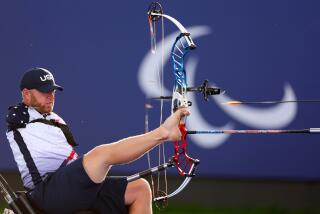Bhutan bows, but it doesn’t bend
- Share via
PARO, BHUTAN — Dorji, a house painter with close-cropped black hair, draws his bowstring, hooks his thumb on his cheek and takes aim at what appears an impossible target: an 11-inch-wide slip of wood dug into the soil 460 feet away -- deeper than center field.
He lets his finger slip and the arrow streaks down the field, raising a puff of dust when it hits the earthen bank just behind the target. He has missed.
“His wife keeps beating him! That’s why he’s getting weaker and weaker!” taunt his friends, gathered in a grove of willows along the rocky Pachu River. Dorji, 47, is accustomed to the insults that are a staple of archery in Bhutan, and just ignores them.
“I like the teasing. It only makes me concentrate more and hit more,” says Dorji, who like many Bhutanese uses only one name.
He sets off for the long walk to retrieve his arrow.
Archery is Bhutan’s national sport, a fixture of life since the days when the Himalayan kingdom’s farmers spent their spare time sharpening their shooting skills just in case the nation needed to take up arms to repel their old enemies, the Tibetans just across the border.
Every town and village boasts an archery grounds, and most men -- the sport remains largely a male domain -- enjoy shooting, or at least watching the arrows fly. For many Bhutanese, archery is less a pastime than a passion.
“We prefer archery even to food,” says Dorji, who has been letting arrows fly for 30 years. “Archery is the most important thing in life.”
The game, played in Bhutan’s national dress, a knee-length kimono-like robe called a gho and knee socks, has made a few nods to modernity. Traditional bamboo bows and reed arrows are slowly giving way to more accurate and expensive fiberglass compound bows. The top-of-the-line model at Yangphel Archery Shop in Thimpu, Bhutan’s capital, is a $950 import from Salt Lake City.
But in this rural, tradition-bound land, much in archery remains ageless. Saplings tied with colorful flags flank targets at either end of any shooting range decorated for competition. Archers win three points for hitting the bull’s-eye, which is less than three inches wide, two points for a strike anywhere on the target, and a single point for hitting within one arrow’s length of the target. Score is kept with scarves tucked into the belt of an archer’s gho. A bull’s-eye is cause for an impromptu celebration of singing and dancing.
Harassing the shooter is part of the game. Taunts fly from competitors and from female “cheerleaders” on the sidelines.
Sometimes spectators, clad in special heavy, padded silk clothing, go as far as stepping into the path of a traditional reed arrow to try to divert it from the target.
“Of course they don’t try that with a compound bow,” notes Ratu, an archery aficionado in Thimpu.
Ratu’s secret weapon on the range, he said, is a pair of earplugs, slipped into place just in time to block out the torments of his opponents.
As in most countries where men regularly spend a bit too much time on their favorite sport, archery is often a source of friction in Bhutanese marriages, particularly when an archer sells a piece of the family farm to buy a better bow, Ratu said.
One afternoon, as Kincho Wangdi nears the end of a long competition with friends, his cellphone trills. It’s his wife, insisting he come home.
“We’re almost done,” he pleads, before proceeding to miss his next shot.
“Now I’ve lost my concentration!” he jokes. “I would have hit it otherwise.” His friends are unmoved.
“Oh, go home and wash your wife’s underwear,” they suggest, laughing.
Bhutan’s archers have not yet made much of an international splash. The country of fewer than 700,000 citizens usually fields a small Olympic archery team, but the nation has so far won medals only in taekwondo. But Wangdi and his friends, specialists at traditional bamboo bow archery, have been invited this June to Washington to show off their impressive talents at the Smithsonian Folklife Festival.
They’re busy this spring putting in extra hours of practice to make a good showing, something none of them mind in the least.
“This is just the best game,” Wangdi says, finally packing up his bow.
“I can keep everything important aside for this.”
In recent years, archery has faced growing competition from soccer and basketball for the hearts of young Bhutanese athletes. The kingdom’s first democratically elected prime minister, voted in to office in March, has blamed cable television for upsetting archery’s dominance -- remote Bhutan allowed in television only in 1999 -- and expressed fears that the game, a key part of Bhutanese culture, could eventually fade in the face of more internationally popular sporting pursuits.
But Bhutan’s archers can’t imagine wanting to play anything else.
“He doesn’t even care what his wife is up to if he can play archery,” teases one of Dorji’s friends as he readies his bow for another shot. This time the arrow sinks deep into the center of the pine target, barely visible at the other end of the long field.
Dorji and his friends whoop and dance.
Then they set off to collect their arrows one more time, for just one more round.
More to Read
Sign up for The Wild
We’ll help you find the best places to hike, bike and run, as well as the perfect silent spots for meditation and yoga.
You may occasionally receive promotional content from the Los Angeles Times.






